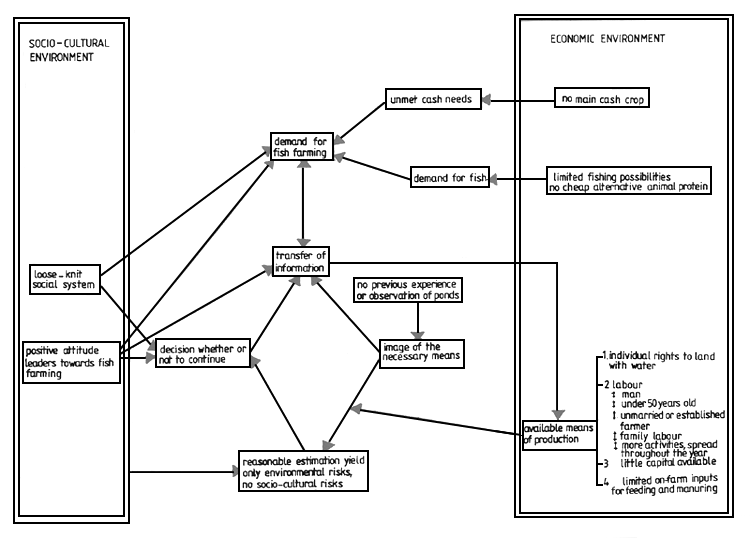The relative importance of certain variables within the socio-cultural and economic environment to the rate of adoption of fish farming has been demonstrated in the preceding paragraphs.
These findings are used to elaborate the model of the adoption of innovation process as described in the field document (FI:GCP/INT/436/SWE.6). The six main steps of the decision process through which a farmer goes can be summarised as follows:
The farmer must feel the need to have fish either for consumption or for sale; if this prerequisite is not met the process will stop since the information he/she might receive on this subject will not be considered of any interest.
Through dissemination of information, potential farmers will be exposed to the existence of fish farming and gain some understanding of how it functions.
The farmer will form ideas about the necessary means.
He/she will compare it with the resources available to him/her.
The farmer tries to estimate the yield and the risks incidental to it.
The farmer forms a favourable or unfavourable attitude toward fish farming and decides if it is an interesting activity in his/her situation.
He/she might look for more detailed information in order to reduce uncertainty about the expected consequences of adopting fish farming. Therefore, he/she can go several times through this process before the final decision is taken.
The demand for fish farming differs in the two areas because many households in Rukuzye fish in the dams, fish consumption is higher and no lack of animal protein is felt during the rainy season. On the contrary, in Magwero there is a perceived supply shortage of animal protein in the rainy season. The introduction of seasonal fish ponds would thus provide for a need.
Notwithstanding this fact, people in Rukuzye still give priority to have fish for home consumption and in Magwero fish farming would be seen as a cash crop. These data suggest that the objective “to have fish for home consumption” is not sufficient to motivate people to construct ponds.
Figure 2: Diagram of the adoption of fish farming process in Rukuzye and Magwero Area

Assuming that the consumption needs are related to household size, these needs can be considered as equal between adopters and non-adopters and neither does the actual fish consumption vary. Because adopters earn less from farming than non-adopters while their consumption needs are equal, it could be inferred that adopters have a higher unmet demand for cash and will look for activities to supplement their household's budget. This supports the hypothesis that the need for cash is the determining factor for the adoption of fish farming.
It is easier for members of a loose-knit social system to adopt an innovation. The rules and norms of who is supposed to take up a new activity first are not as strong as in a close-knit system. Those who want to start fish farming can do so without endangering his or her situation.
It appears that those people with limited means of production have taken up fish farming despite the fact that they consider it a tedious job. This has to be taken into account in the technology proposed.
Survey data and field observations suggest that fish farming can be a relevant activity in certain phases in the development of a household. Young, unmarried men adopted fish farming in order to earn money. Their consumption needs are still secured by their parents, which makes it easier for them to take risks and free labour for other activities. Besides, they have little money to invest. Since the financial costs of fish farming is low, it suits their situation. A newly wed couple on the other hand, has to secure the food production first. In addition they will probably grow a known cash crop or do some piece work to meet their cash needs. When they feel they are “settled”, they may consider taking up new, unfamiliar, activities. When the head of the household is old and has no adult sons staying with him, the lack of labour will be a constraint for the construction of a pond. The same holds true for female headed households. This constraint can only be overcome when employing people for the construction, if they have the necessary resources at their disposal.
When comparing data on the perceived newness of fish farming in Rukuzye and Magwero, one could conclude that fish farming has taken off in Magwero because many people were already familiar with it. However, if farmers knew about fish farming then why didn't they copy it and take it up themselves? An indication was found when data were subdivided between adopters and non-adopters. The non-adopters have seen significantly more ponds than the adopters which would imply that seeing a fish pond had a negative influence on their decision to adopt fish farming. The respondents who had seen ponds have not automatically heard about fish farming. Often they draw conclusions on the necessary means without discussing the subject. A wrong idea concerning the minimum requirements may discourage those farmers who are not in the possession of these means of production.